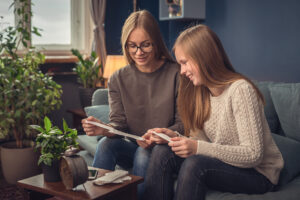First Period for Girls
 The monthly phenomenon of menstruation is a reality for many women: legs and breasts get swollen, cramps arrive, and the uterine lining does its monthly job. Though in our adult years we are more or less prepared for this arrival, there was a time when we were expecting our periods like a rite of passage into womanhood. The time for the Very First Period! It may have been years since yours, but you also may have a young teen in your life who is now where you once were, waiting for her first menstrual cycle to make its appearance.
The monthly phenomenon of menstruation is a reality for many women: legs and breasts get swollen, cramps arrive, and the uterine lining does its monthly job. Though in our adult years we are more or less prepared for this arrival, there was a time when we were expecting our periods like a rite of passage into womanhood. The time for the Very First Period! It may have been years since yours, but you also may have a young teen in your life who is now where you once were, waiting for her first menstrual cycle to make its appearance.
How can you be prepared to have a first period conversation?
Whether it is your daughter, niece, younger sister, a cousin, or a younger friend, you can share some simple facts with the young woman in your life who may have questions about her menstrual cycle. Most people start their periods around the age of 12, but a little earlier or later is not unusual. With puberty, our bodies start becoming capable of reproduction: first the breasts start developing, and a few years later menstruation begins.
Your period may knock on your door without any warming, or you may experience pre-menstrual syndrome (the infamous PMS). Some common symptoms include acne, breast swelling and soreness, abdominal bloating, back pain, and clear or vaginal discharge. You may also find yourself feeling more tired than usual, as well as more irritable or emotional. Constipation and diarrhea are also not uncommon.
When it’s Time
It’s always good to be prepared and awaiting the arrival of your period is no exception. Many people carry a period kit in their bags, which can include clean underwear, a pad or a tampon, wipes, and pain relievers. If you have that with you, great! But sometimes we’re not prepared… worry not, female ingenuity goes a long way—you can make a pad out of toilet paper! Take at least ten pieces of TP and fold them one over another to form a rectangular. Place this in the middle part of your underwear and wrap some TP around it on the opposite direction, tucking in the end of it on the rectangular piece to hold it in place. Though far from perfect, this is still a way to protect your clothing and feel a little more comfortable.
What about the Pains?
Period cramps happen because the uterine lining has prepared itself for a fertilized egg, but hasn’t received any, so it’s now thickened and discharging itself. You can help alleviate the pains by taking some ibuprofen or naproxen. If you have any allergic reactions to medications, be careful which one you choose! You can also use a warm pad on your belly or take a hot shower. Many women find it helpful to walk around some or consume more water than usual.
It may be super daunting at first but remember that the more you learn your body’s symptoms as time goes by, the more prepared you will be and the easier it will get. And if you’re reading this to give advice to a younger menstrual sufferer, remember that your personal experience goes a long way!
